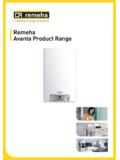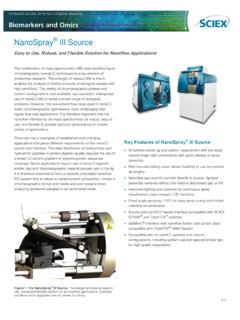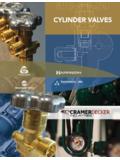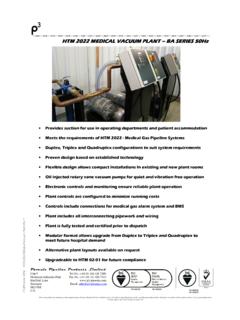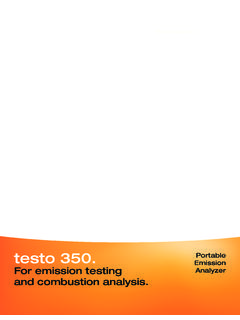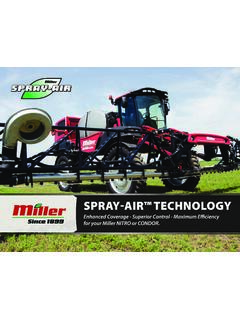Transcription of HSE Information Sheet - Testing regime for offshore …
1 HSE Information Sheet Testing regime for offshore TR-HVAC fire dampers & TR pressurisation requirements offshore Information Sheet No 1/2006 (Revised and reissued January 2007). Contents: Introduction ..2. Background ..2. Applicable Approach to the Testing of TR HVAC fire dampers ..3. TR Pressurisation and pressure decay measurement ..4. Evidence of poor test standards and maintenance difficulties ..5. Further advice ..6. Introduction This Information Sheet provides guidance for duty holders on better practice in Testing HVAC fire dampers to achieve a reliability and availability approaching 100%. It also provides guidance on the basis for temporary refuge (TR). pressurisation and to advise on the Testing requirements to achieve a positive internal pressure for the specified TR endurance time.
2 Background Most safety cases attribute a high availability to TR fire damper successful closure, and this target is a fundamental criterion for the risks to persons estimate in establishing a case for safety for the installation. Many safety cases quote a ~99% fire damper availability, and for the purposes of this guidance this is taken as an achievable target in developing TR HVAC. performance standards. The hazard from failure of HVAC fire dampers to close on demand is defined as a loss of TR habitat via gas/smoke ingress etc. A TR HVAC fire damper has two purposes:- i. To provide fire protection for the TR structure and HVAC inlet & outlet ducting to the same standard as the fire rating of the wall it is penetrating. ii. To provide some sealing function to prevent excessive TR air outflow and the ingress of toxic smoke and gas for the specified TR.
3 Endurance time, which is usually about 1 hour. Note that fire dampers are not designed to provide a hermetic level of sealing. Fire dampers may also be referred to as boundary dampers. Although the primary purpose of HVAC fire dampers is to maintain the fire protection integrity of the TR, they also help mitigate against an inflow of toxic fumes to the TR volume. However this is an integral measure together with internal pressurisation to prevent ingress of toxic fumes for the specified endurance period. Internal pressurisation is necessary because TR structures are leaky boxes' with air leakage from doors, windows, domestic drain systems, particularly unused cabins where the water in U' bend seals has evaporated, and gaps in the structures' cladding. Internal pressure should be high enough to maintain positive pressure for the specified endurance time.
4 Some platforms have executive action to shut in the TR HVAC on smoke or gas detection in process or drilling modules. On others the philosophy is one of alarm' in TR/CCR and only executive action on detection of gas/smoke at the TR inlets. It is important that the philosophy of TR damper closure is based on the platforms risk assessment and not on some convenience aspect' of the control systems. Best practice is seen as executive action to shut-in on gas or smoke detection at any location on the platform until the extent of the hazard is fully evaluated. Resumption of TR pressurisation should be based on the risk based decision making process, and other factors such as the various design features and operational conditions of the installation as well as the prevailing weather conditions. However the TR impairment risk assessment should have identified the optimum course of action to maximise TR integrity, which may - 2 - not include TR shut-in on gas in a process area.
5 Some installations for example, may only shut-in the TR on smoke or gas at the TR inlets. Applicable Regulations In addition to the general duties imposed on duty holders by sections 2 and 3. of the Health and Safety at Work etc Act 1974 (HSWA), and the demonstrations required by Reg. 12 of the offshore Installations (Safety Case) Regulations 2005 (SCR05), three other Regulations apply to TR HVAC. fire damper operations and TR pressurisation. These are the offshore Installations (Prevention of Fire and Explosion, and Emergency Response). Regulations 1995 (PFEER) Reg. 13 (a & b) - Mitigation of Fires and Explosions; 14(1) - Muster Areas, etc; Reg 19(1) -Suitability and Condition of Plant. offshore Installations (Safety Case) Regulations 2005. Regulation 12(1) of SCR05 requires that duty holders demonstrate that risks to persons from major accident hazards have been evaluated and measures have been, or will be, taken to control those risks to ensure that the relevant statutory provisions will be complied with.
6 As major accidents' include fires and explosions, toxic gas generation resulting from these events should be considered in this demonstration. Further Information on Regulation 12 is contained in the guide to the Regulations (paragraphs 176-186)1. Approach to the Testing of TR HVAC fire dampers TR HVAC fire dampers on the main and secondary (if fitted) air intakes/outlet ducts are generally attributed a ~99% reliability value. This performance standard should be clearly demonstrated by a history of regular and frequent tests. Full loop tests are tests that use the TR HVAC's full detection and control system, smoke or gas (methane or propane) is applied to an instrument head somewhere in a process or drilling module, as the initiating event for damper closure. Fire detection instruments could also be used as the initiating event.
7 Clear indication that the initiating sequence is a full loop is required with a demonstration from maintenance/test records. In the period 2005-2006 HSE's offshore Division's (OSD) KP3 inspection initiative on installation integrity has identified significant failings in the TR. HVAC effectiveness. Of 17 systems tested eight were found to have serious, and a further five, minor defects. Most of these failings were found to be the fire dampers failing to operate as designed. On this basis it is recommended that duty holders re-evaluate the suitability of the present frequency and depth of functional Testing carried out on all safety critical HVAC dampers. Testing should be carried out at a frequency that assures their required reliability/availability, which should be equivalent to safety integrity level (SIL).
8 2 categorisation. It is recommended that fire dampers are stroked once per month and preferably more frequently, to ensure their continual free movement. This test/exercise' frequency is commensurate with a SIL 2 with an associated PFD of 10-2 to 10-3. Investigation and Testing of the associated instrument and control systems gas and smoke detection, indicates that these systems have a SIL 2 reliability. - 3 - A second criterion for ensuring TR damper effectiveness is the enunciation of damper closure within the TR (CCR/ECR) so that individuals do not have to leave the safe haven (TR) to check that the dampers are closed. Clear indication that dampers have closed-in is required with a demonstration from maintenance/test records that they have done so reliably over the last few years. As part of this test procedure each TR HVAC inlet/outlet damper should be checked by personnel and their status recorded.
9 Best practice is for the damper blades to be visible either externally or from an inspection hatch. It is recommended that access/inspection hatches are retro-fitted where access is currently difficult or not possible without significant support services scaffold. A third criterion is the time-to-damper-closure from smoke/gas appearing at the TR HVAC inlet dampers. There have been several recent examples whereby the HVAC intake gas/smoke detectors took several minutes to detect the gas and hence close the dampers. There have been no reported cases, within the KP3 inspection initiative, of slow damper fin movement. Damper closure times should be measured in seconds to minimise the contamination of breathable atmosphere. ISO 151382 quotes 2-4 seconds from the initial closure signal. Calculations should also be carried out to estimate the time for smoke or gas to reach the internal TR spaces from the inlet duct.
10 Gas/smoke flow times can be used in TR endurance estimates. The issue of concern here are the two competing regimes of high air flow into the duct and the diluting effect this has on any gas presence at the duct. It is known (1998 High Momentum Gas release JIP3) that high airflow rates can cause boundary layer formation that inhibits gas mixing and so helps defeat gas detection systems. The problem seems to be the geometric arrangement of detector heads in the inlet duct, wind direction and probably boundary layer formation as the air is accelerated into the duct, and the detectors set points. OSD has commissioned the Health and Safety Laboratory (HSL) to investigate the gas detector arrangements in HVAC inlets. TR Pressurisation and pressure decay measurement It is common practice in the offshore industry to pressurise TR's to between 50 and 75 Pa.










